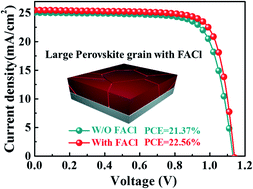Long-term stable and highly efficient perovskite solar cells with a formamidinium chloride (FACl) additive†
Abstract
Although the power conversion efficiency (PCE) of organometal halide perovskite solar cells (PSCs) has reached 25.2%, control of the crystallization process and its impact on film quality is still one of the main challenges. Here, a new perovskite growth method using formamidinium chloride (FACl) as an additive is introduced to enlarge the crystal grain size and improve the quality of the perovskite film. Strikingly, the champion power conversion efficiency of FA0.85MA0.15PbIxBr3−x-based and Cs0.05FA0.85MA0.10Pb(I0.97Br0.03)3-based PSC devices reaches 21.02% and 22.56%, respectively. The hysteresis index is found to decrease from 0.101 to 0.005, which is attributed to suppressed ion migration and surface charge trapping. Besides, the better film quality with FACl significantly increases the environmental stability of the perovskite films, yielding devices that maintain 90% of their initial efficiency after 1200 h under ambient air conditions, whereas the pristine devices without FACl only maintain 50% of their initial efficiency. Our solar cells processed with additives also achieve retardation of degradation of the PCE with a considerably enhanced environmental stability. This work offers a promising route through crystallization management to achieve high performance and stable PSCs.



 Please wait while we load your content...
Please wait while we load your content...